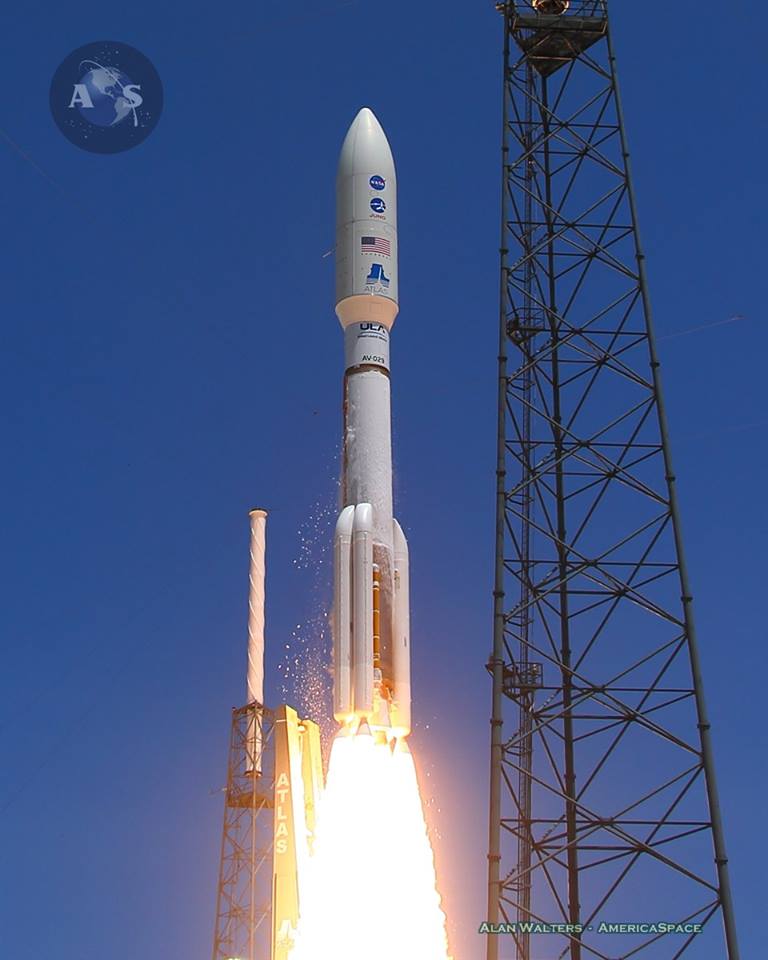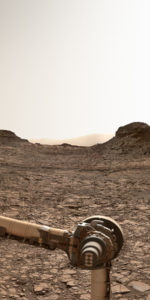
Jupiter, with its complex layers of clouds and storms, is revealing itself to be a multifaceted jewel of a planet. Over forty years after the first observations of Jupiter, our Solar System’s largest gas giant, NASA’s Juno spacecraft has returned data and images from its first orbit.
Juno was able to image the planet’s north pole, which shows features previously unseen, including a distinctive cloud pattern. In addition, the first infrared close-ups of Jupiter were taken, showing extensive auroral activity at both the north and south poles. During the first of its 37 planned orbits, Juno passed within 2,500 miles (4,200 kilometers) of Jupiter’s cloud tops, giving scientists and researchers on Earth the most intimate view yet of our Solar System’s behemoth planet.
Up-Close and Personal With Jupiter’s North Pole
NASA reported that Juno’s six-hour transit from Jupiter’s north to south pole yielded six megabytes of data, which took 1.5 days for the ground to download. When the download was complete, Juno’s scientists were rewarded with discoveries that further uncovered Jupiter’s mythic mystique. According to Juno’s Principal Investigator (PI) Scott Bolton of the Southwest Research Institute in San Antonio, Texas, the spacecraft’s images revealed unknown facets of the gas giant concerning its cloud patterns.
Bolton enthused: “First glimpse of Jupiter’s north pole, and it looks like nothing we have seen or imagined before. It’s bluer in color up there than other parts of the planet, and there are a lot of storms. There is no sign of the latitudinal bands or zone and belts that we are used to—this image is hardly recognizable as Jupiter. We’re seeing signs that the clouds have shadows, possibly indicating that the clouds are at a higher altitude than other features.”

In addition, Jupiter possesses a distinct divergence from a neighboring, ringed gas giant. NASA’s Cassini spacecraft, which continues to survey Saturn, best imaged Saturn’s unique polar regions. Juno, however, discovered that Jupiter has a very different landscape. “Saturn has a hexagon at the north pole. There is nothing on Jupiter that anywhere near resembles that. The largest planet in our solar system is truly unique. We have 36 more flybys to study just how unique it really is.” It is hoped Juno’s next orbits will reveal even more about the complex cloudscape at Jupiter’s north pole.
Juno’s mission builds upon one launched well over 40 years ago, right after Apollo wrapped up and before a single space shuttle was even built. In December 1974, the Pioneer 11 spacecraft closely approached the planet during a flyby, and took the first clear images of Jupiter’s north pole. While Pioneer 11 advanced our knowledge of the largest gas giant by leaps and bounds, it only completed a single flyby, and took a very limited number of images. Juno’s orbits will allow it to repeatedly survey Jupiter’s polar regions throughout its entire mission, planned to complete in February 2018. At mission’s end, the spacecraft will take a plunge into Jupiter’s atmosphere.
Juno Instrument Illuminates “Fiery” Auroral Activity at Poles
Juno’s Jovian Infrared Auroral Mapper, which was supplied by the Italian Space Agency, managed to capture fiery images of the gas giant’s polar regions, showing extensive auroral activity. These images are unique in that they cannot be viewed from telescopes, or by any other methods on Earth. Jupiter’s auroras have been observed by the Hubble Space Telescope (HST), a NASA/ESA collaboration which has been orbiting Earth since 1990. But until now, no one has viewed this phenomenon in such detail. Alberto Adriani, JIRAM co-investigator from Istituto di Astrofisica e Planetologia Spaziali, Rome, underscored why the data gleaned from his country’s instrument is essential to Juno’s mission.

“These first infrared views of Jupiter’s north and south poles are revealing warm and hot spots that have never been seen before. And while we knew that the first-ever infrared views of Jupiter’s south pole could reveal the planet’s southern aurora, we were amazed to see it for the first time. No other instruments, both from Earth or space, have been able to see the southern aurora. Now, with JIRAM, we see that it appears to be very bright and well-structured. The high level of detail in the images will tell us more about the aurora’s morphology and dynamics,” he related.
Jupiter’s intense polar auroras are believed to be created not only by solar storms, but also by the planet’s own powerful magnetic field. It is hoped JIRAM, along with Juno’s other science instruments, will continue to shed light (pardon the pun) upon this distinctive facet of Jupiter.
Juno has also captured the haunting “music” of Jupiter, as the planet emits a curious pattern of radio emissions, with its instrument called the Radio/Plasma Wave Experiment (Waves). These sounds, according to Bill Kurth, co-investigator for the Waves instrument from the University of Iowa, Iowa City, are actually inextricably linked to the auroras: “Jupiter is talking to us in a way only gas-giant worlds can. Waves detected the signature emissions of the energetic particles that generate the massive auroras which encircle Jupiter’s north pole. These emissions are the strongest in the solar system. Now we are going to try to figure out where the electrons come from that are generating them.”
*****
While several spacecraft (including but not limited to the Pioneer, Voyager, and Galileo spacecraft) have explored the “King of the Solar System,” Juno’s first orbit gave scientists the first ever pole-to-pole observation of Jupiter. Juno’s five-year-long trek to Jupiter began on Aug. 5, 2011, from Florida’s Cape Canaveral Air Force Station’s Launch Complex 41 aboard a United Launch Alliance (ULA) Atlas V 551 launch vehicle. Now, after reaching its destination after a five-year-long journey, the solar-powered, basketball court-sized spacecraft continues to reap a rich scientific harvest, not only revealing secrets about bejeweled Jupiter, but also illuminating the origins of our Solar System.


.
Want to keep up-to-date with all things space? Be sure to “Like” AmericaSpace on Facebook and follow us on Twitter: @AmericaSpace
.






Well done as always Emily. A fun read about a great mission.
Emily,
Is Jupiter an unlit star?
It is not. It simply is not massive enough, it would need to contain about 13 times more mass in order to support Deuterium fusion.
“Everyone will be filled in on the details via a live video stream on Monday, Sept. 26, at 2 p.m. EDT, according to the release:
Astronomers will present results from a unique Europa observing campaign that resulted in surprising evidence of activity that may be related to the presence of a subsurface ocean on Europa.”
From: ‘NASA will soon reveal a ‘surprising’ discovery about a moon of Jupiter that may support life’ By Dave Mosher,Business Insider https://www.yahoo.com/finance/news/nasa-soon-reveal-surprising-discovery-032243453.html